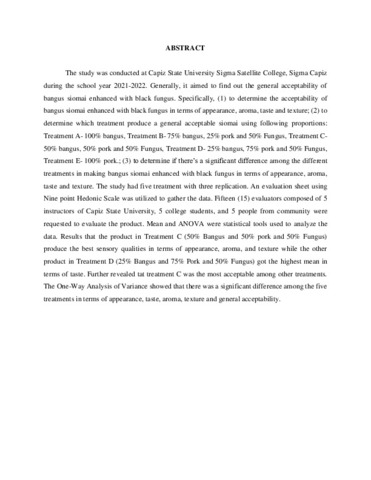Acceptability of bangus siomai enhanced with black fungus (langot-langot)
| dc.contributor.advisor | Bacalangco, Emelda R. | |
| dc.contributor.author | Pioquinto, Kimberly C. | |
| dc.date.accessioned | 2024-09-20T05:39:28Z | |
| dc.date.available | 2024-09-20T05:39:28Z | |
| dc.date.issued | 2023-06 | |
| dc.identifier.citation | Pioquinto, K.C., Demalata, G.F., Vargas, J.F., & Frusa, J.F. (2023). Acceptability of bangus siomai enhanced with black fungus (langot-lagot) [Undergraduate thesis, Capiz State University Sigma Satellite College]. CAPSU Institutional Repository. | en |
| dc.identifier.uri | https://repository.capsu.edu.ph/handle/123456789/746 | |
| dc.description.abstract | The study was conducted at Capiz State University Sigma Satellite College, Sigma Capiz during the school year 2021-2022. Generally, it aimed to find out the general acceptability of bangus siomai enhanced with black fungus. Specifically, (1) to determine the acceptability of bangus siomai enhanced with black fungus in terms of appearance, aroma, taste and texture; (2) to determine which treatment produce a general acceptable siomai using following proportions: Treatment A- 100% bangus, Treatment B- 75% bangus, 25% pork and 50% Fungus, Treatment C- 50% bangus, 50% pork and 50% Fungus, Treatment D- 25% bangus, 75% pork and 50% Fungus, Treatment E- 100% pork.; (3) to determine if there’s a significant difference among the different treatments in making bangus siomai enhanced with black fungus in terms of appearance, aroma, taste and texture. The study had five treatment with three replication. An evaluation sheet using Nine point Hedonic Scale was utilized to gather the data. Fifteen (15) evaluators composed of 5 instructors of Capiz State University, 5 college students, and 5 people from community were requested to evaluate the product. Mean and ANOVA were statistical tools used to analyze the data. Results that the product in Treatment C (50% Bangus and 50% pork and 50% Fungus) produce the best sensory qualities in terms of appearance, aroma, and texture while the other product in Treatment D (25% Bangus and 75% Pork and 50% Fungus) got the highest mean in terms of taste. Further revealed tat treatment C was the most acceptable among other treatments. The One-Way Analysis of Variance showed that there was a significant difference among the five treatments in terms of appearance, taste, aroma, texture and general acceptability. | en |
| dc.publisher | Sigma Satellite College, Capiz State University | en |
| dc.subject | Acceptability | en |
| dc.subject | Bangus | en |
| dc.subject | Siomai | en |
| dc.subject | Black fungus | en |
| dc.subject.lcsh | Milkfish | en |
| dc.subject.lcsh | Dumplings | en |
| dc.title | Acceptability of bangus siomai enhanced with black fungus (langot-langot) | en |
| dc.type | Thesis | en |
| dc.contributor.chair | Bacalangco, Emelda R. | |
| dc.contributor.committeemember | Mongan, Violeta F. | |
| dc.contributor.committeemember | Murguia, Jenny B. | |
| thesis.degree.discipline | Food Service Management | en |
| thesis.degree.grantor | Capiz State University Sigma Satellite College | en |
| thesis.degree.level | Undergraduate | en |
| thesis.degree.name | Bachelor of Technical Vocational Teacher Education | en |
| dc.subject.agrovoc | milkfish | en |
| thesis.degree.department | Technical Teacher Education Department | en |
| dc.subject.scientificname | Chanos chanos | en |
| dc.subject.scientificname | Auricularia polytricha | en |

